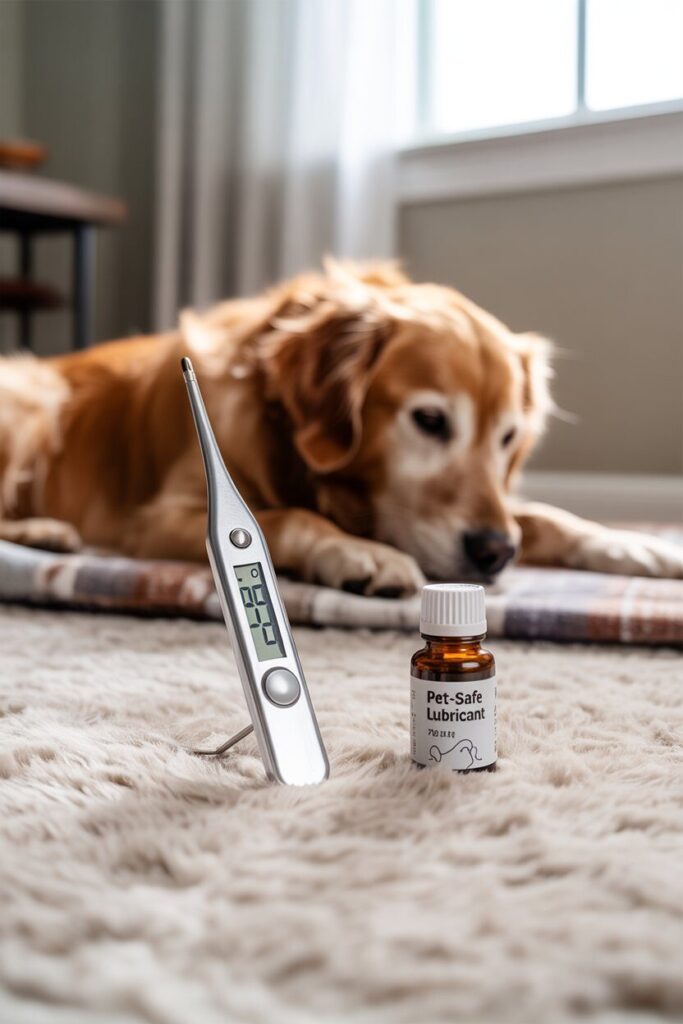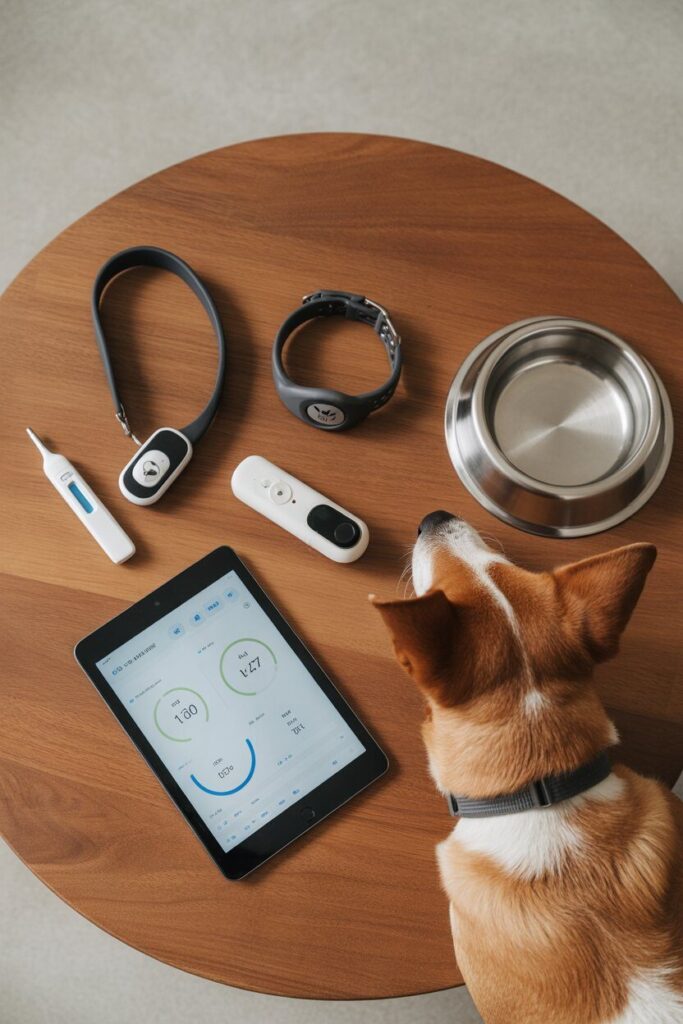You love your dog, right? Of course! But here’s the deal: dogs can’t just hop on the couch and say, “Hey, my heart feels off today.” That’s why knowing how to monitor your dog’s vitals at home is a game-changer.
You don’t need to be a vet or wear a lab coat. Just a bit of know-how and some patience will do (since, spoiler alert, your pup won’t always sit still).
I’ve been there, struggling with a thermometer while my dog gives me the “are you done yet?” look. Trust me, once you get it down, it’s as easy as checking if there’s coffee left.
Let’s break this down step by step so you can confidently track your furry friend’s health.
Why Monitoring Vitals at Home Matters
Think of monitoring vitals as your early warning system. You spot changes before they become emergencies.
- Temperature spikes could hint at infections.
- Fast breathing might mean respiratory issues.
- A weak pulse could point to something serious with circulation.
And honestly, it just gives you peace of mind. Why wait until something feels off when you can check regularly and know your pup is in good shape?
The Big Four Vitals You Need to Track

When it comes to how to monitor your dog’s vitals at home, focus on these four:
- Temperature
- Heart Rate
- Respiratory Rate
- Capillary Refill Time (CRT)
These give you the best snapshot of your dog’s overall health. Let’s tackle each one.
Check out these vet-recommended tools for dogs on Amazon today
Checking Your Dog’s Temperature

Tools You’ll Need
- A digital rectal thermometer (yep, it’s the most accurate).
- Lubricant (a dab of petroleum jelly works).
- Some treats for afterward, because your dog will definitely deserve them.
How to Do It
- Gently lift your dog’s tail.
- Insert the thermometer about an inch into the rectum.
- Wait until it beeps.
- Remove, read, and reward your pup.
What’s Normal?
A dog’s normal temperature is 101 to 102.5°F (38.3 to 39.2°C).
Anything above 103°F is a fever. Below 99°F is a red flag for hypothermia. Call the vet if you get either of those readings.
Pro tip: I know this step isn’t exactly glamorous, but accuracy matters. Ear thermometers for dogs exist, but IMO they’re often less reliable.
Measuring Your Dog’s Heart Rate

Where to Feel the Pulse
- Place your fingers on the inside of the back leg where the thigh meets the body (the femoral artery).
- Or, if your dog is calm, put your hand directly on the chest behind the left elbow.
How to Count
- Count beats for 15 seconds.
- Multiply by 4 to get beats per minute.
Normal Ranges
- Small dogs/puppies: 100–160 BPM
- Medium/large dogs: 60–100 BPM
- Working or athletic breeds: Can be even lower at rest
If your dog’s heart feels like it’s running a marathon while lying on the couch, something’s off.
Shop trusted home health monitors for dogs now on Amazon
Tracking Respiratory Rate

How to Measure
- Watch your dog’s chest rise and fall.
- Count breaths for 30 seconds.
- Multiply by 2 for breaths per minute.
Normal Rate
10 to 30 breaths per minute at rest is healthy.
If your dog is panting after a run, fine. But if they’re breathing hard while chilling on the rug, that’s a signal.
Pro tip: Do this when your dog is calm or even asleep. That way you’ll get the truest reading.
Capillary Refill Time (CRT)

This one’s surprisingly easy and super telling.
How to Check
- Gently lift your dog’s lip.
- Press your finger against the gums until they blanch.
- Release and watch the color return.
Normal
Color should bounce back in 1–2 seconds.
Longer refill time can signal circulation issues or shock. If that happens, don’t wait—call the vet immediately.
Find the best pet vital check devices easily on Amazon
Other Useful Checks
Sure, the “big four” are key, but a full health check includes a few extras.
Gum Color
- Healthy gums: Pink and moist.
- Bad signs: Pale, blue, bright red, or sticky gums.
Hydration Test
- Pinch the skin at the back of the neck.
- If it snaps back quickly, your dog is hydrated.
- If it stays tented, dehydration is likely.
Body Weight
Regular weigh-ins help you spot slow weight loss or gain that could signal problems.
How Often Should You Check Vitals?
Great question. The answer: it depends.
- Healthy dogs: Once a month is fine.
- Senior dogs or those with conditions: Weekly or even daily.
- If something feels off: Right away.
The goal isn’t to become obsessive. It’s to have a baseline so you notice changes.
Making It Less Stressful for Your Dog

Let’s be honest, no dog jumps for joy when you approach with a thermometer. So how do you make this less of a wrestling match?
- Stay calm: Your dog mirrors your energy.
- Use treats: Positive reinforcement works wonders.
- Start slow: Practice touching paws, ears, and chest without taking readings at first.
Eventually, your dog will roll with it, even if they give you the occasional side-eye.
When to Call the Vet Immediately
Knowing how to monitor your dog’s vitals at home is empowering, but you’re not replacing your vet. Call them if you see:
- Temperature above 103°F or below 99°F
- Heart rate that stays high at rest
- Breathing that’s labored or noisy
- CRT longer than 2 seconds
- Gums that aren’t pink
Trust your gut. If something feels wrong, it probably is.
Tech That Helps

Yes, there’s tech for this too. Pet wearables can monitor heart rate, activity, and even sleep. Think of them as Fitbits for dogs. Are they perfect? Not always. But they’re handy for spotting trends, especially if you like data.
Popular gadgets include:
- Smart collars that track heart and respiratory rates
- Wireless thermometers
- Activity monitors that connect to apps
I personally like using them as backups, not substitutes. Nothing beats hands-on checks, but it’s cool to get a graph of your dog’s rest patterns.
Creating a Dog Health Journal

You don’t need to go full spreadsheet nerd here (unless that’s your thing). Just jot down the numbers in a notebook or phone app.
Record:
- Temperature
- Heart rate
- Respiratory rate
- CRT time
- Weight
Why? Because trends matter. If the heart rate slowly climbs week after week, you’ll catch it before it becomes a crisis.
Final Thoughts
Learning how to monitor your dog’s vitals at home doesn’t just make you a more informed dog parent. It makes you proactive, confident, and ready to step in when your pup needs you most.
Sure, it might feel awkward at first, and yes, your dog might look at you like you’ve lost your mind during a rectal temperature check. But in the end, it’s worth it.
So grab that thermometer, keep some treats handy, and start making vital checks part of your routine.
Your dog can’t tell you when something’s wrong, but with a little practice, you’ll be able to read the signs before things get serious.
And let’s be real—keeping them healthy is the least we can do for all the love (and slobber) they give us every day.
What Are the Most Important Vitals to Monitor in Dogs?
The four key vitals to track at home are temperature, heart rate, respiratory rate, and capillary refill time (CRT). They provide a clear view of your dog’s health and help you catch problems early.
Other checks, like gum color, hydration, and body weight, are important too. However, the “big four” should be your main focus. Once you know your dog’s normal numbers, you can spot issues more easily.
How Can I Take My Dog’s Temperature at Home?
The best way to measure a dog’s temperature at home is with a digital rectal thermometer. Insert it about an inch into the rectum, wait for the beep, and read the result.
This method may feel uncomfortable for you and your dog, but it’s the most accurate.
A dog’s normal temperature is between 101–102.5°F (38.3–39.2°C). A reading above 103°F means your dog has a fever. If it’s below 99°F, your dog may be hypothermic. Both cases require a call to your vet right away.
How Do I Measure My Dog’s Heart Rate?
You can check your dog’s pulse by putting your fingers on the inside of the thigh where the femoral artery is or by resting your hand on the chest just behind the left elbow.
Count the beats for 15 seconds and then multiply by 4 to find beats per minute.
The normal range depends on size: smaller dogs and puppies typically have 100–160 BPM, while larger dogs usually have 60–100 BPM.
If your dog’s heart feels too fast or irregular while resting, it’s a good idea to have them checked.
How Often Should I Monitor My Dog’s Vitals?
For healthy dogs, a monthly check is usually enough. If your dog is senior, has a medical condition, or seems “off,” check weekly or daily as your vet advises.
The key is consistency. Regular checks help you spot subtle changes. It’s better to act early than wait for a health emergency.
When Should I Call the Vet After Checking My Dog’s Vitals?
Call your vet right away if you see readings outside normal ranges. For instance, a temperature above 103°F or below 99°F, an unusually high resting heart rate, or labored breathing at rest are all warning signs.
Gums that are pale, blue, or very red also signal serious health issues.
Trust your instincts. If your dog acts strangely with abnormal vitals, don’t hesitate. Quick action can greatly impact your dog’s recovery and long-term health.
